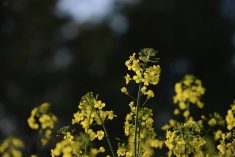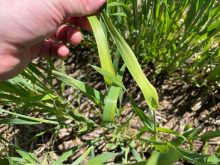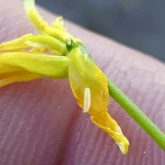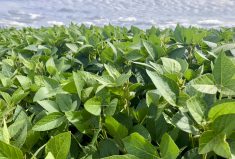The third time’s the charm for Darryl Boersma, who won Ontario’s 2022 Canola Challenge with 4,875 lbs./acre yields.
“I was really fortunate with the right weather, timing, and field. That’s the biggest thing,” Boersma said during the Ontario Canola Growers Association (OCGA) annual general meeting.
Why it matters: Winter canola is becoming another profitable rotation crop for farmers in southern Ontario.
Read Also

Women who fed a nation
More than 40,000 young women supported the war effort between the 1940s and early 1950s, helping grow and harvest crops amid labour shortages. They were called Farmerettes.
Boersma planted Mercedes winter canola on a historically high-yielding 60-acre sandy loam field on Tulip Acres Inc., his Mt. Brydges farm.
Previous to winter canola, the crop rotation included 85 lbs./acre soybeans followed by a 135 lbs./acre wheat crop.
“Someone asked me, what’s your secret?” Boersma laughed. “Well, it’s not much of a secret because I’ve planted three canola fields in my life — and I’ve only ever harvested one. So, I have no recipe for success.”
The first two canola attempts were hindered by unseasonably cold, wet weather or a plant failure to thrive following emergence.
Before planting, Boersma fortified the soil with variable rate lime, potash, and K-mate to address deficiencies pinpointed in a soil sample. Despite the field registering phosphate levels between 150 and 400 Boersma had to spread 6,000 gallons/acre of liquid hog manure which came with the rented land.
The land was disc ripped, smoothed, rolled and left to rest in mid-August. He applied Round-Up days before his Sept. 3 plant date, followed by volunteer wheat clean-up shortly after.
A late April application of 100 lbs./acre nitrogen and 20 lbs./acre sulphur and a May 12 Cotegra fungicide application brought him into the home stretch before he applied desiccant in mid-July.
“I didn’t know what to expect; I didn’t know if my crop looked good. It was even, but that’s all I had to go by,” he said, adding it took two weeks to kill the green. “It was so healthy.”
The delay meant he couldn’t double-crop soybeans as planned, but he’s happy with the yields.
Using Mercedes, Jonathon Blydorp, of Amaranth, with 4,377 lbs./acre and Robert and Dallas Hunter, of Hillier, with 3,087 lbs./acre, round out the top three winter canola yields.
The top spring canola yield went to Clifford, Ont.’s Jared McLaughlin, of McLaughlin Farms, with 4,220 lbs./acre using InVigor L340.
McLaughlin planted in Harriston loam, with excellent drainage, crop rotation and fertility of 50 ppm P and 150 ppm K.
“Compared to the field average across all 165 acres, it was about half a tonne more,” said Heidi Frey, of Harriston Agromart, who spoke on behalf of McLaughlin Farms. “The previous crop was soybeans, which is not a normal crop rotation for them. Usually, they grow canola following corn or wheat.”
McLaughlin turbo-tilled in the fall and spring, applied manure, and planted on May 12, with a seed rate of 10 acres per bag. He utilized seed-placed MESZ with Puryield at 20-40-0-10S1Zn as a starter and pre-plant broadcast incorporated with Urea and AMS. No in-season nitrogen was applied because the manure was rich.
Crop protection included Liberty sprayed at two-to-three leaves with Crimson in place of AMS and Voliam at bolting, based on swede midge trap counts, said Frey.
At flower, McLaughlin applied Proline and one litre per acre foliar Boron while employing regular scouting for insect pressure.
“In our area, we had just phenomenal yields across the board,” said Frey. “We got some timely rains that other areas didn’t get, and overall insect and disease pressure were really low.”
Melancthon’s Mark Coe placed second with 4,065 lbs./acre InVigor L255 and Haasen Farms harvested 3,722 lbs./acre in Timmins using InVigor L340.
Canola acreage continues to grow
The 2022 canola growing season was uneventful, with low swede midge damage and some white mould pressure for northwest growers who encountered heavy May rainfalls following favourable planting conditions.
“Those wet conditions did persist for the remainder of the year, which promoted some heavy mould pressures for a few growers,” said Abigail Wiesner, Ontario Ministry of Agriculture, Food and Rural Affairs (OMAFRA) canola and edible bean specialist.
“On the flip side, down south, we saw drought conditions later in the summer (and) Grey County reported drought stress on their crop.”
Winter canola acres continue to grow, hitting an estimated 15,000 acres in 2022, up several thousand over the previous year.
“Some great warm conditions within the fall promoted great growth,” Wiesner pointed to a photo of a Sarnia field planted in August. “By Nov. 11, the rosette had already produced up to 12 leaves and was roughly about my knee height, which is some great conditions. Hopefully, it will promote some really great winter survival.”
Wiesner said the total acres of winter and spring canola hit 46,506 with yields of 2,650 pounds per acre, besting that 10-year average of 2116 pounds per acre.
Agricorp reported, with the exception of Haldimand, Hamilton, Niagara and Waterloo, that all counties experienced canola yields at 110 to 140 per cent of average farm yields in 2022.
“With the growing success of winter canola in the southwest of Ontario and the return of sizable acres in northern Ontario, I think this bodes well for the future of canola,” said Will Runnalls, OCGA acting president. “But we still have challenges.”
Canola growers continue to use management and agronomy techniques and research to mitigate seed supply, winter canola survivability, club root and swede midge pressure on spring canola.
Ryan Koeslag, OCGA executive director, said tariffs attached to Russian and Belarus fertilizer imports continue to create tensions.
Canada mandated sanctions and a 35 per cent tariff after Russia’s February 2022 invasion of Ukraine.
“Our government request has always been to return the fertilizer tariffs charged to Ontario grain farmers, canola farmers, bean growers,” Koeslag said. “Especially for any product purchased prior to February 2022.”
At the end of 2022, Koeslag spoke to federal Agriculture and Agri-Food Minister Marie-Claude Bibeau. She indicated returning some of the $34 million collected to the farming industry was possibly in the form of on-farm storage for fertilizer or discounts on shipping through CN and CP Rail, he said.
In December, the federal government announced its investment of the $115 million in tariffs collected from Russia and Belarus to rebuild Ukraine’s electrical infrastructure.















